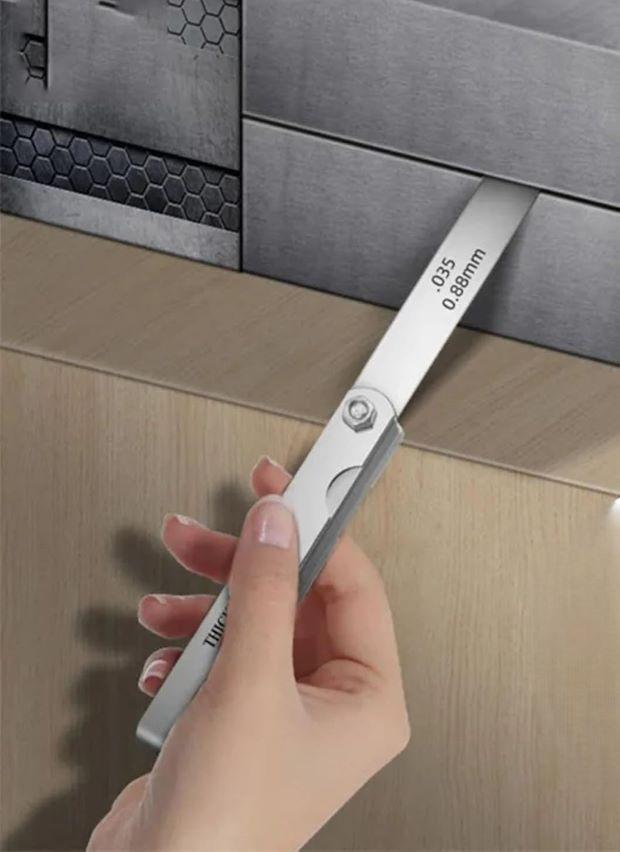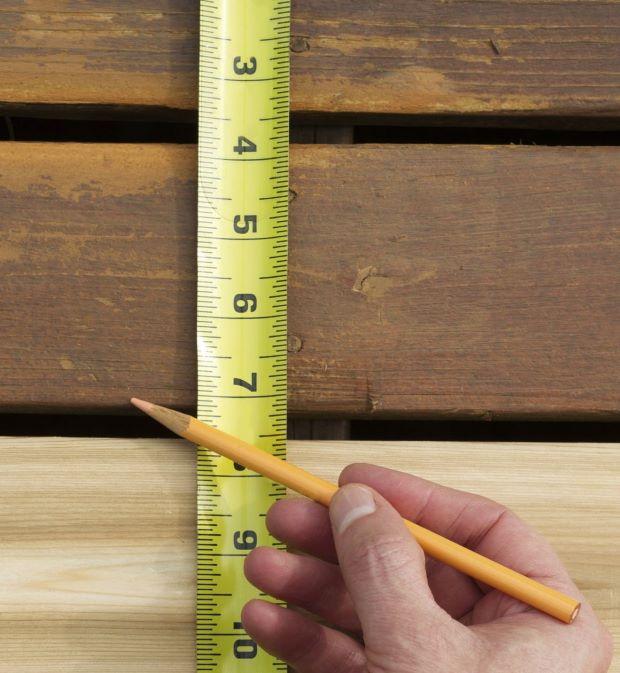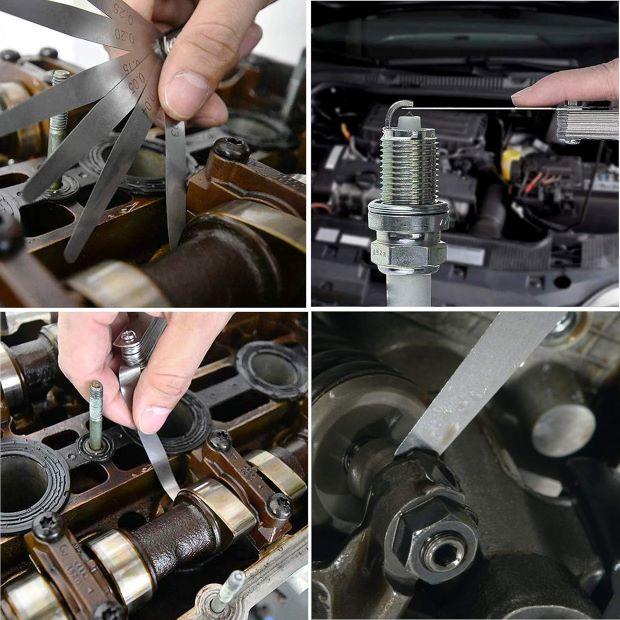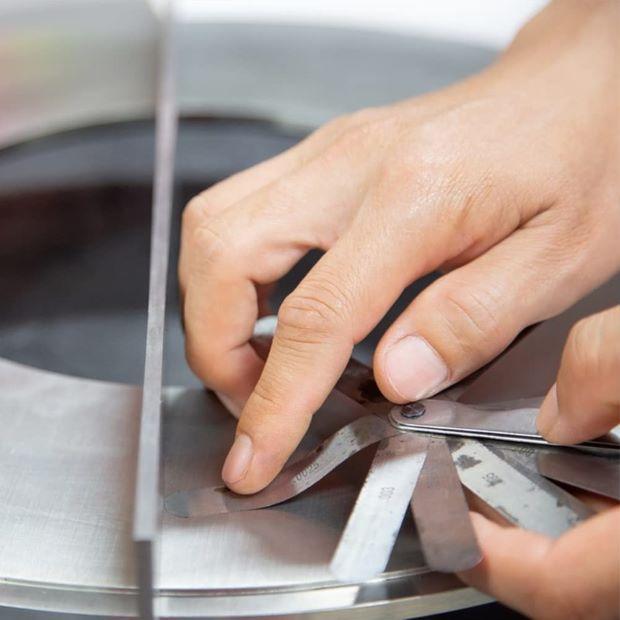The feeler gauge is a measuring instrument used to determine the thickness between materials, ensuring very high precision.
What is a feeler gauge?
A feeler gauge It is an instrument used to accurately measure the thickness of small spaces or cracks.
It is composed of a series of thin sheets metal, each of which has a specific thickness indicated in millimetres or hundredths of a millimetre.
Thickness Gauge with 32 Blades – Photo Spurtar
This tool is widely used in the field mechanical and industrial to check the distance between surfaces or to check the uniformity of a thickness. The measurements are engraved directly on each sheet, making it easy to find the correct value to use.
Some examples of common measurements reported on the plates are:
- Lamina and 0,05 mm (5 hundredths of a millimeter)
- Lamina and 0,1 mm (10 hundredths of a millimeter)
- Lamina and 1 mm (100 hundredths of a millimeter)
Each feeler gauge can hold a variable number of sheetswhich cover a wide range of measurements.
How to Use a Feeler Gauge Correctly
Using a feeler gauge requires precision and attention to achieve accurate measurementsthe first step is to select the correct sheet based on the thickness you want to measure.
 Using a Feeler Gauge – Photo TMRBBesty
Using a Feeler Gauge – Photo TMRBBesty
If the foil is too thick, it will not fit into the gap, while if it is too thin, it will pass through too easily.
Once you have chosen the correct foil, you can insert in the space to measure. The foil should pass through easily, but there should not be too much play between the foil and the surfaces. If the passage is too easy, a thicker foil should be selected.
DIY Uses of the Feeler Gauge
In addition to its use in the field mechanicalthe feeler gauge is a very versatile tool that finds application in a variety of DIY and other industries.
In the field of carpentrythe feeler gauge can be used to check the thickness of sheets of wood or to check the uniformity of cuts and joints in projects that require precision, such as furniture construction or wooden structures.
 Measuring this distance is easier with a feeler gauge – Getty Image
Measuring this distance is easier with a feeler gauge – Getty Image
In light metalworking, the feeler gauge allows you to check the thickness of sheet metal or gaskets, helping to avoid coupling errors or structural defects.
Even in the DIY workcome laying wooden floors or creating joints, the feeler gauge can be useful to ensure that the distances or thicknesses of the materials are uniform and compliant with the design.
Combination of plates in the thickness gauge for intermediate measurements
When you need it intermediate measuresyou can combine multiple sheets to obtain the desired thickness.
 Various uses of the feeler gauge in mechanics – Photo Spurtar
Various uses of the feeler gauge in mechanics – Photo Spurtar
For example, to measure 0.15 mm, you can use a 0.1 mm and a 0.05 mm foil together. However, to ensure maximum accuracy, it is advisable use the least number of sheets possible to reach the desired thickness. .
The more overlapping plates, the greater the risk of introduce errors in measurement, especially when it comes to measuring spaces with very tight tolerances.
Feeler gauge care and replacement of the instrument
Taking care of your feeler gauge is essential to ensure the precision of measurements over time.
The foils, especially the thinner ones like 0.05mm or 0.1mm, tend to to bend with frequent use, especially if the instrument is not handled carefully.
 Better not to bend the blades too much – Xpex Photo
Better not to bend the blades too much – Xpex Photo
Once a sheet bends, its accuracy is compromised, and the feeler gauge will no longer be reliable. In these cases, it is not possible to replace a single sheet, but it is necessary change the entire feeler gauge.
Continuing to use a feeler gauge with bent blades can lead to incorrect measurementswith potentially serious consequences, especially in contexts where precision is crucial, such as in the mechanical or industrial fields.
Tips for the correct use of the feeler gauge
To ensure accurate measurement and extend the life of the feeler gauge, it is important to follow some practical advice.
The feeler gauge is a very compact instrument – Photo Pimaldaum
First of all, try to combine il fewer sheets possible to obtain the desired thickness, so as to minimize errors. Furthermore, it is advisable clean regularly the laminate after use, so as to avoid dust or residue affecting the measurement.
The accumulation of dirt between the sheets or on the surfaces to be measured can alter the results. Another good practice is to avoid bending or applying too much pressure on the sheets, especially the thinner ones, to avoid damaging them.
Advantages of the feeler gauge over using the caliper
The feeler gauge offers some advantages compared to the caliberespecially when it comes to measuring extremely small spaces or very thin thicknesses with a high degree of precision.
While the caliper is ideal for general measurements of length, diameter and depth, the feeler gauge is specifically designed to check minimum thicknesses and tight tolerances.
 Certain measurements can only be taken with a feeler gauge – Photo KLLJ
Certain measurements can only be taken with a feeler gauge – Photo KLLJ
Thanks to its thin and flexible blades, the feeler gauge can easily fit into spaces that a caliper would not be able to reach, such as small cracks between two surfaces.
Furthermore, the feeler gauge allows you to measure with a precision that the caliper cannot guarantee when it comes to thicknesses. less than 1 mm.
Another advantage is the ease of use of the cumulative measurement feeler gauge: by combining several sheets, the desired measurement can be obtained, which is not possible with a traditional gauge.
Source: www.lavorincasa.it


 The feeler gauge is a very compact instrument – Photo Pimaldaum
The feeler gauge is a very compact instrument – Photo Pimaldaum